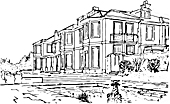Mullard Space Science Laboratory
P R E S S R E L E A S E
17 February 2005
REF: CASS2005-1
FEELING THE PRESSURE - SATURN'S AURORA
The aurora allows us to see magnetospheres in action. The control of Saturn's aurora, by the solar wind or by the rapid rotation of Saturn, is a long standing question now partially answered by a paper in Nature on 17 February - and a new aspect of the control is discovered.
In Earth's magnetosphere, 'magnetic reconnection' between oppositely directed magnetic fields plays the dominant role in how the magnetosphere interacts with the solar wind. At Saturn the new results show that while reconnection is present, the role of the solar wind pressure is even more important.
As well as heat and light, the Sun emits a million tonnes per second of solar wind. The solar wind is gusty, carries the Sun's magnetic field, and sometimes shocks travel in front of outbursts of solar material. Just like terrestrial winds, the pressure changes in the gusts.
The unique opportunity of seeing Saturn's aurora from HST, while measuring the solar wind upstream as Cassini approached Saturn, made the solar wind control of Saturn's magnetosphere become visible. This is seen in two striking images just before and after a solar wind shock arrived at the ringed planet on 25 January 2004.
The major new result in the paper by Crary et al (Frank Crary, Southwest Research institute, and includes as authors, Dr Andrew Coates and Abi Rymer from UCL's Mullard Space Science Laboratory) is that the pressure of the solar wind, rather than the magnetic field direction, controls the aurora.
Dr Andrew Coates of MSSL-UCL, who leads the team responsible for the electron spectrometer (part of CAPS) says 'With our new results we are re-writing the textbooks on solar wind control of Saturn's beautiful aurora. We find that rather than reconnection, the solar wind pressure dominates in driving Saturn's dynamic magnetosphere. It's like pushing on a balloon on one side and the balloon distorts. This seems to be the dominant effect at Saturn'.
Since these measurements, Cassini-Huygens, one of the great undertakings of exploration of our time, has orbited Saturn, flown by (and Huygens landed on) Titan. Amongst many fascinating discoveries is exciting new information on the ringed giant's magnetosphere in which the UK is playing a key role.
Dr Andrew Coates and Abi Rymer are co-authors on the Crary et al paper.
ENDS.
THE MSSL CASSINI TEAM INCLUDES:
Dr Andrew Coates - lead co-investigator for CAPS electron spectrometer (and co-author on paper)
Dr Abi Rymer - postdoctoral researcher working on Cassini data (and co-author on paper)
Hazel McAndrews - postgraduate student working on Cassini data
Dave Linder - Cassini ELS project manager
Gethyn Lewis - Cassini operations software specialist
Lin Gilbert - Cassini operations software specialist
Notes to Editors:
1. The Mullard Space Science Laboratory, situated at Holmbury St Mary, is the Department of Space and Climate Physics of University College London. About 120 people work on space science and space engineering. The Laboratory plays key roles in many missions of space exploration. Over 250 instruments have been launched into space to date, to study astrophysics, solar and stellar physics, plasma and planetary physics and climate physics.
2. The electron spectrometer (ELS) is one of three sensors in the Cassini Plasma Spectrometer instrument (principal investigator Dr D.T. Young at Southwest Research Institute, San Antonio, Texas). RAL and FFI (Norway) also contributed hardware for ELS.
3. Images are available on request
C O N T A C T S:
Mullard Space Science Laboratory
University College London
Holmbury St. Mary, Dorking
Surrey, RH5 6NT
MSSL switchboard: 01483 204100
MSSL website: www.mssl.ucl.ac.uk
Dr Andrew Coates - lead co-investigator for CAPS electron spectrometer (and co-author on paper)
Dr Abi Rymer - postdoctoral researcher working on Cassini data (and co-author on paper)
Hazel McAndrews - postgraduate student working on Cassini data
Dave Linder - Cassini ELS project manager
Gethyn Lewis - Cassini operations software specialist
Lin Gilbert - Cassini operations software specialist
